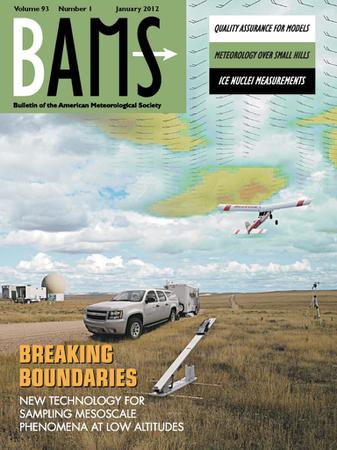云根-亚马逊22:通过跨尺度整合云与光合作用
IF 5.9
1区 地球科学
Q1 METEOROLOGY & ATMOSPHERIC SCIENCES
引用次数: 0
摘要
摘要 雨林光合作用和湍流通量如何受到云的影响?云在多大程度上受到雨林能量、水和碳通量驱动的本地过程的影响?这些相互关联的问题是 2022 年 8 月旱季期间在亚马逊雨林 ATTO/Campina 超级站点进行的云根-亚马逊 22 强化实地实验的主要驱动力。CloudRoots-Amazon22收集了观测数据,以得出从叶片到树冠发生的过程与晴天到阴天的昼夜变化之间的因果关系。首先,我们研究了云层和冠层辐射扰动对气孔导度亚昼夜变化的影响。气孔开放在早晨较大,受云层光学厚度的影响。其次,我们将二氧化碳和水蒸气稳定同位素的 1 赫兹频率测量值与湍流测量值相结合,以确定冠层内二氧化碳和水蒸气的源和汇。通过闪烁计观测,我们推断出了 1 分钟的显热通量,该通量在几分钟内对云层的移动做出了反应。第三,状态变量和温室气体的同位剖面使我们能够确定云在垂直传输中的作用。然后,我们利用冠层和高层大气观测数据以及参数化方法,推断出了云层覆盖率和云质量通量,从而确定了冠层和云层过程之间的因果关系。这表明需要全面的观测数据来改进天气和气候模式的表示方法。我们的研究结果有助于增进我们对亚马逊雨林多云边界层与原始碳生产力之间耦合关系的了解。本文章由计算机程序翻译,如有差异,请以英文原文为准。
CloudRoots-Amazon22: Integrating clouds with photosynthesis by crossing scales
Abstract How are rainforest photosynthesis and turbulent fluxes influenced by clouds? To what extent are clouds affected by local processes driven by rainforest energy, water and carbon fluxes? These interrelated questions were the main drivers of the intensive field experiment CloudRoots-Amazon22 which took place at the ATTO/Campina supersites in the Amazon rainforest during the dry season, in August 2022. CloudRoots-Amazon22 collected observational data to derive cause-effect relationships between processes occurring at the leaf-level up to canopy scales in relation to the diurnal evolution of the clear-to-cloudy transition. First, we studied the impact of cloud and canopy radiation perturbations on the sub-diurnal variability of stomatal conductance. Stoma opening is larger in the morning, modulated by the cloud optical thickness. Second, we combined 1 Hz-frequency measurements of the stable isotopologues of carbon dioxide and water vapor with measurements of turbulence to determine carbon dioxide and water vapor sources and sinks within the canopy. Using scintillometer observations, we inferred 1-minute sensible heat flux that responded within minutes to the cloud passages. Third, collocated profiles of state variables and greenhouse gases enabled us to determine the role of clouds in vertical transport. We then inferred, using canopy and upper-atmospheric observations and a parameterization, the cloud cover and cloud mass flux to establish causality between canopy and cloud processes. This shows the need of comprehensive observational set to improve weather and climate model representations. Our findings contribute to advance our knowledge of the coupling between cloudy boundary layers and primary carbon productivity of the Amazon rainforest.
求助全文
通过发布文献求助,成功后即可免费获取论文全文。
去求助
来源期刊
CiteScore
9.80
自引率
6.20%
发文量
231
审稿时长
6-12 weeks
期刊介绍:
The Bulletin of the American Meteorological Society (BAMS) is the flagship magazine of AMS and publishes articles of interest and significance for the weather, water, and climate community as well as news, editorials, and reviews for AMS members.

 求助内容:
求助内容: 应助结果提醒方式:
应助结果提醒方式:


